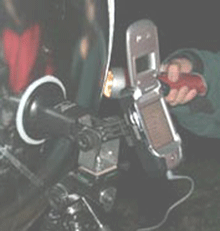 |
Cell phone technologies are increasingly adopted by researchers in biology, public health and the arts to learn and interact with natural environments. These specialized cell phones offer the ability probe and gather minute-by-minute information from remote often hard to reach locations. |
Imagine mobile phones outfitted with customized microphones, cameras and specialized sensors to pick up sounds, sights, and smells generated by animals, plants and the climate. Large number of such devices could upload large amounts of valuable real-time data to centralized computers to be instantly analyzed, with reports made accessible to the public.
 |
 |
The "Human-Environment Mobile-Based Interactions" workshop is supported by a grant from the National Science Foundation and will be hosted by D. Joachim's Ecology Media Group at MIT Media Laboratory on September 15 and 16. Scientists, technologist and artists will convene for this two-day workshop at the MIT Media Lab to discuss current and future potential of mobile-based technologies to enhance interactions with natural enviroments. Mobile device technology has already given rise to many intriguing projects. Dr. Dale Joachim, an electrical engineer with a passion for environmental conservation along with his team have designed the first automated, interactive cell phone network to assess bird populations in Maine. Using a distributed array of mobile devices, each attached to a cluster of microphones and speakers they broadcast calls of different owl species, then tracked owls’ responses to assess specie populations. Calls of various kinds of animals could as well be listened to, automatically recognized and compiled into census. Computers might eventually be trainined to recognize individual animals.
 |
 |
Projects in agronomy and public health are using mobile technology for pest control. Mobile devices are used to remotely and quickly detect the presence of species that threaten humans or crops. The computer responds by notifying local health officials, who take appropriate action (spraying for pests, distributing mosquito nets, etc.). A system could even bypass humans, and directly activate devices that repel or kill the pest. Mobile technology projects provide social advantages, as well. They typically involve many devices dispersed across a large area, and therefore depend on the assistance of many individuals on the ground. Dubbed “citizen science,” such projects allow people with or without academic credentials to participate first-hand in research and experiential learning.
 |
 |
Mobile device projects are also “scalable”: for little cost, they can expand to include more data and more locations. Results can be viewed and understood on multiple levels – from global to national or regional to local. In the future, mobile technology could allow us to virtually visit places where we cannot physically travel. For instance, it could offer new ways for persons with disabilities to interact with nature. It could also provide a means of virtual tourism and exploration to remote, impassible or fragile environments.
 |
